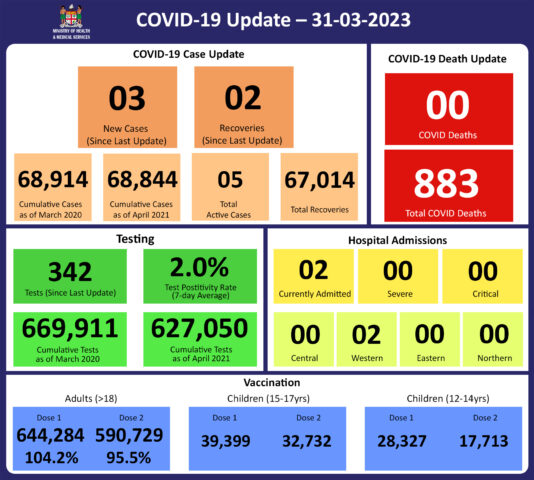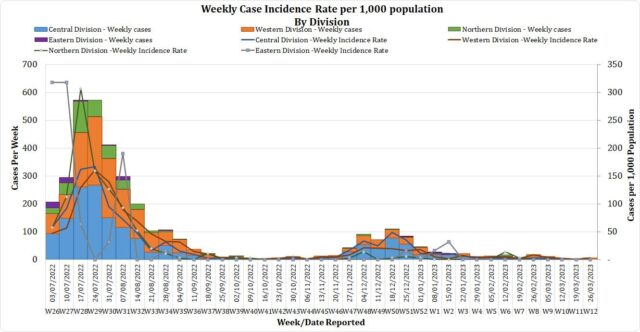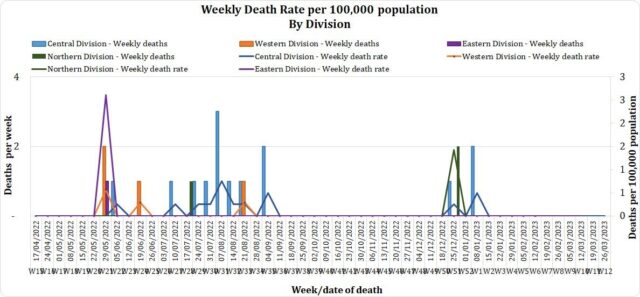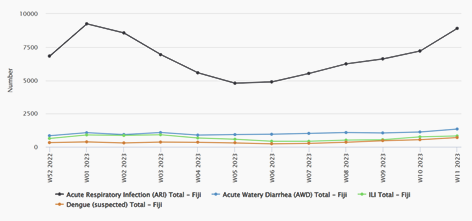COVID-19 Update 31-03-2023
COVID-19 Weekly Update
Friday 31st March
| Transmission Update:
Since the last update on 23/03/23, we have recorded 3 new cases. 2 cases were recorded in the Central Division; 1 case in the Western Division; with nil cases in the Eastern Division and Northern Division. The national 7-day rolling average of cases as of 26th March is 1 daily case. The Central Division cases constitute 66% of the cumulative total cases nationally, with the Western division making up 28%, 4% in the Northern Division, and 2% in the Eastern Division. |
||||||||||||||||||||||||||||||||||||||||||||||||||||||||||||||||||||
| Deaths:
The curve depicts weekly COVID-19 deaths by division since May 2021. It indicates a surge from last December, with peaks in mid-January 2022 followed by a downward trend. COVID Death Reports We have no (0) new COVID-19 deaths to report. Analysis of COVID-19 Deaths Table 1: Death rates by Division
An analysis of the 182 deaths recorded since December 2021, shows that the Central Division has the highest absolute number of deaths. The Northern Division has the highest rate of death when adjusted for population. Table 2: Deaths by Age Group
The death rate adjusted per 100,000 population, has been highest in the age group 50 years and over for the 182 deaths since December 2021. There were ten (10) deaths below the age of 19 years, 7 out of the 9 children had significant pre-existing medical conditions, and three (3) children had no known underlying medical condition. Table 3: Deaths by Vaccination Status
Of the 182 COVID-19 deaths reported since December 2021, eight (8) deaths were in the population not eligible for vaccination (under the age of 12). An analysis of the 174 deaths in the vaccine-eligible population revealed that Fiji has a death rate of 12.4 per 100,000 population for fully vaccinated adults and 344.4 per 100,000 population for unvaccinated adults. This means that unvaccinated adults in Fiji have been dying at a rate 27.8 times higher than fully vaccinated adults. Individuals in the 12-17 age group who died were not vaccinated. There has been a total of 883 deaths due to COVID-19 in Fiji. As of December 25th, 2022, the national 7 days rolling average for COVID-19 deaths per day is 0.0 with a case fatality rate of 1.28%. Due to the time required by clinical teams to investigate, classify and report deaths, a 4-day interval is given to calculate the 7 days rolling average of deaths, based on the date of death, to help ensure the data collected is complete before the average is reported. We have also recorded 1,006 COVID-19-positive patients who died from other serious medical conditions unrelated to COVID-19; their doctors have determined that COVID-19 did not contribute to their deaths, and therefore these are not classified as COVID-19 deaths. |
||||||||||||||||||||||||||||||||||||||||||||||||||||||||||||||||||||
| Hospitalisation:
Currently, we do not have any (0) admissions as a direct cause of COVID-19. However, two (2) admissions have tested as covid positive but are admitted for other diseases. Patients presented to the hospital are tested before admission therefore, a high number of people who are admitted for non-covid health conditions, test positive for COVID-19 due to the current level of transmission in the community. Using the WHO clinical severity classification, there are 100% (n=2) cases in the moderate category; with nil cases in the asymptomatic and mild, severe, and critical categories. |
||||||||||||||||||||||||||||||||||||||||||||||||||||||||||||||||||||
| Testing:
59 tests had been reported for 29th March 2023. The total cumulative tests since 2020 are 669,911 tests. And the 7-day daily test average is 48 tests per day or 0.1 tests per 1,000 population. The national 7-day average daily test positivity is 2.0% which is within the WHO recommendation of 5%. |
Public Advisory
LTDD Situation up to 26th March
For Leptospirosis, we continue to see an upward trend in the weekly incidence of cases – case numbers were noted to be above the Outbreak Thresholds for each of the 4 divisions and nationally. Cumulatively to date, the majority of lab-reported Leptospirosis cases are from the Western Division (37%), followed then by the Central, Northern, and Eastern Divisions. The majority of lab-reported cases are male (55%) or I-Taukei (75%). Most affected are persons in the 10-29 years old age group. This rise in cases is expected given the current weather conditions.
The general incidence trend of Typhoid continues at or is below the Average Threshold, EXCEPT for the Western Division where the incidence rate is approaching the Outbreak Threshold. The majority lab reported cases were male (57%), or in the 10-39 years old age group. The lab-reported cases are predominantly i-Taukei.
There remains a concerning upward trend in the incidence of cases of Dengue throughout all the divisions. Whilst most of the laboratory-reported cases are in the Northern (35%) and Central (31%), upward incidence trends in the Western (23%) and Eastern Divisions (11%) have driven the National trend to surpass the Outbreak Threshold.
The majority of lab-reported cases are male (53%) or i-Taukei (55%), and most affected persons are in the 10-39 years old age group.
We appeal to the public to be aware of the dangerous signs of fever Please immediately seek medical care if you develop any of the following symptoms:
- Difficulty breathing or shortness of breath
- Pain or heaviness in the chest
- Inability to stay awake or confusion
- Severe muscle pain
- Weakness and unsteadiness
- Worsening of a chronic condition such as Diabetes or Hypertension
- Any other symptom of concern, for example, severe vomiting
We continue to be encouraged that despite the rise in cases, severe cases needing ICU care remain manageable. This is likely due to more awareness leading to timely access to medical care
We continue to request the public to keep their surroundings clean and free from mosquito breeding sites. We are also requesting people wear appropriate footwear in muddy areas and areas with stagnant water. Our health inspectors have been diligently going out to inspect places of concern and actively applying punitive measures to property owners who have not been compliant in keeping their environment clean. Proper adherence to hand cleaning before meals and after using the washroom is strongly encouraged. We also encourage the public to be aware of the early indications of LTDD and ensure early presentation. Despite the high number of LTDD cases, we are grateful that severe disease cases have not been as high as before, primarily because more cases are being treated early.
Influenza and Acute Respiratory Illness
As indicated by the graph below, our surveillance systems show that the resurgence in influenza-like illness and acute respiratory illness continues. There are reports suggesting an increase in absenteeism rates in schools and workplaces.
Earlier this year, we had an outbreak of a type of Influenza type A virus scientifically labelled as FluA/H1 Pdm. This outbreak had receded however, we now have indications of another outbreak of Flu-like illness. Essentially, we are observing a “double peak trend” (bi-phasic) of Influenza-like illness (ILI) case reports over the last several months since December 2022. As observed from past years’ trends, Fiji’s influenza season usually runs from January to May-June annually.
The Fiji CDC confirms that Influenza B/Victoria is now the predominant influenza strain in circulation, and likely the cause of this ‘second’ surge of ILI cases being reported and observed locally. It must be noted that this increased presence of influenza B in circulation is similarly being observed in other countries of the region and the world.
We have Tamiflu (antiviral medications) stock which is being distributed and we are getting more Flu vaccines which will be offered to those vulnerable to the severe effects of Influenza (individuals with chronic illness, pregnant women, and to frontline staff. Surveillance has also been escalated and we await more recent reports to determine ongoing trends. Whilst we still have stocks of flu testing reagents and consumables, we are also working with WHO to increase our stocks.
The Ministry of Health and Medical Services advises members of the public to stay at home when feeling unwell or wear face coverings (masks) when going outside in order to minimize the spread of infection.
We also advise that people living with chronic disease and children, especially babies, need to be protected from the severe effects of influenza. This entails preventing infection by proper masking in crowded and/or poorly ventilated spaces, early recognition of the symptoms, and seeing a doctor early. It is essential that these vulnerable persons are carefully monitored to ensure early access to intervention if severe symptoms develop.
Preventative measures will be familiar as they are essentially the same as for COVID-19. Wear a mask that covers your mouth and nose when in a public place, wash your hands frequently with soap and water or use an alcohol-based hand sanitizer, avoid crowds, stay home if you are sick, and cover your mouth and nose if you cough or sneeze.
Seek medical care: For adults, see a Doctor if the following danger symptoms develop; difficulty breathing or shortness of breath, pain or heaviness in the chest, persistent fever ( more than 3 days, despite home treatment), very high temperature (over 40°C), feeling sicker as time goes by, confusion and persistent drowsiness, severe headache that doesn’t respond to painkillers and unusual symptoms such as hallucinations, severe vomiting, neck stiffness, skin rash, rapid heart rate, chills, uncontrollable shivering, or muscle spasms.
For children, seek medical care right away if your child:
- has a fever greater than 38°C for more than two days, or a fever of 40°C or higher for any amount of time
- has a fever of 38°C or higher and is under 3 months old
- has a fever that doesn’t get better after taking Panadol
- seems unusually drowsy or lethargic
- won’t eat or drink
- is wheezing or is short of breath
For COVID-19;
There is a continuing report of COVID-19 cases however our case numbers are declining and likewise absenteeism rates from selected industries. We however continue to focus on implementing COVID safe measures around those vulnerable to the severe effects of COVID-19. This includes escalating measures in hospitals, old people’s homes, and facilities catering to disabled persons. As such we expect to escalate screening protocols and masking for staff, patients, and visitors. Furthermore, visitor restrictions will be in place.
We currently enjoy a high level of protection from severe disease and as such we have supported the rescinding of all vaccine mandates. So far despite the surge in cases, the impact on hospital admission has remained manageable. There is expected to be some immune escape capability that makes the variant more transmissible. The elderly, those with chronic diseases, pregnant mothers, and children with disabilities need to be closely watched in this regard.
We emphasise the point that strengthening our ability to live with COVID means we remain vigilant, maintain community-wide adoption of COVID safe measures where appropriate, and keep the impetus for immunization. This is the only means to reduce the disease spread and protect those in the community who are less able to fend for themselves.
Also, anyone who falls sick should not be attending work or school, especially if they have COVID-19-like symptoms. You must get tested for COVID-19, and if tested positive, 5-day isolation is mandatory.
COVID-19 Vaccination
We have been reporting that 100% of our estimated adult population have received one dose and 95% have received the second dose. The vaccination of our target population has been progressing well with the 12 years and above coverage rate for Fiji being 99% for Dose 1 and 89% for Dose 2.
Additionally, as of the 31st of March, 171,997 (55%) booster-eligible individuals have so far received their 3rd dose while 29,897 individuals have been administered the 4th dose.
Increasing Vaccine Booster Coverage Program
The following COVID-19 vaccination services are currently offered at the sites:
- 1st and 2nd dose of COVID-19 vaccines for 12 years and above
- 1st and 2nd dose of COVID-19 boosters for 18 years and above
An individual is eligible for the first booster dose 3 months after receiving the 2nd dose of the COVID-19 vaccine and the 2nd booster dose 4 months after receiving the 1st booster dose.
The public is advised that the COVID-19 vaccination program for children aged 5-11 years old is currently unavailable and the Ministry will advise once the program resumes.
To register online for the first dose, please visit vra.digitalfiji.gov.fj
The public is reminded that vaccination sites strictly close at 3 pm. Therefore, any person going to the site in the afternoon is requested to be present at least by 1.30 pm.
Sites for vaccination will be operational from 9 am – 3 pm each day (Monday – Friday) while Suva Health Center will also operate on Saturdays (9 am – 3 pm).
The list of sites is available at: bit.ly/35Fozux
Last Updated on 1 year by Publishing Team




